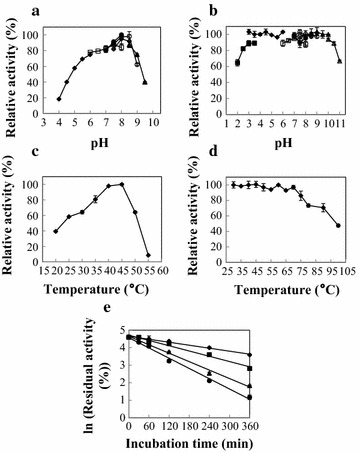Fig. 5.

Optimal pH (a), pH stability (b), optimal temperature (c), thermostability (d), and thermal denaturation half-lives (e) of McCut. The optimal pH was determined at 45 °C in 50 mM of different buffers. To determine pH stability, the enzyme was incubated in various buffers at 50 °C for 30 min, and the residual activity was measured. Buffers used were as follows: glycine–HCl (filled square), pH 2.0–3.5; citrate (filled diamond), pH 3.0–6.0; phosphate (open square), pH 6.0–8.0; Tris–HCl (open circle), pH 7.0–9.0; HEPES (filled circle), pH 7.0–8.0; Tricine (open diamond), pH 7.5–8.5; CHES (filled triangle), pH 8.0–10.0; and CAPS (open triangle), pH 10.0–11.0. For optimal temperature, the enzyme activity was assayed at temperatures ranging from 20 to 55 °C in 50 mM Tris–HCl (pH 8.0). The thermostability was investigated by incubating the enzyme at 30–100 °C in 50 mM Tris–HCl (pH 8.0) for 30 min. The residual activity was measured as described in the “Methods” section. For determination of thermal denaturation half-lives, McCut was incubated at different temperatures in 50 mM Tris–HCl (pH 8.0) for 6 h, and the residual activities at different time points were measured. The temperatures used were 70 °C (filled diamond), 75 °C (filled square), 80 °C (filled triangle), and 85 °C (filled circle). All data are mean values of triplicate measurements
